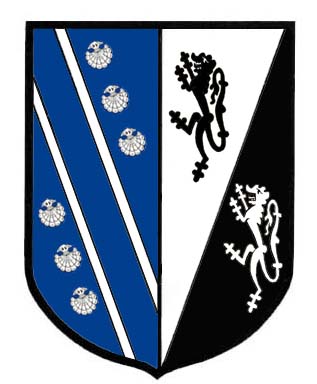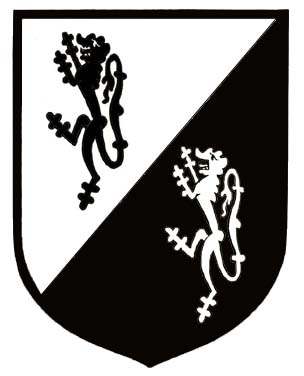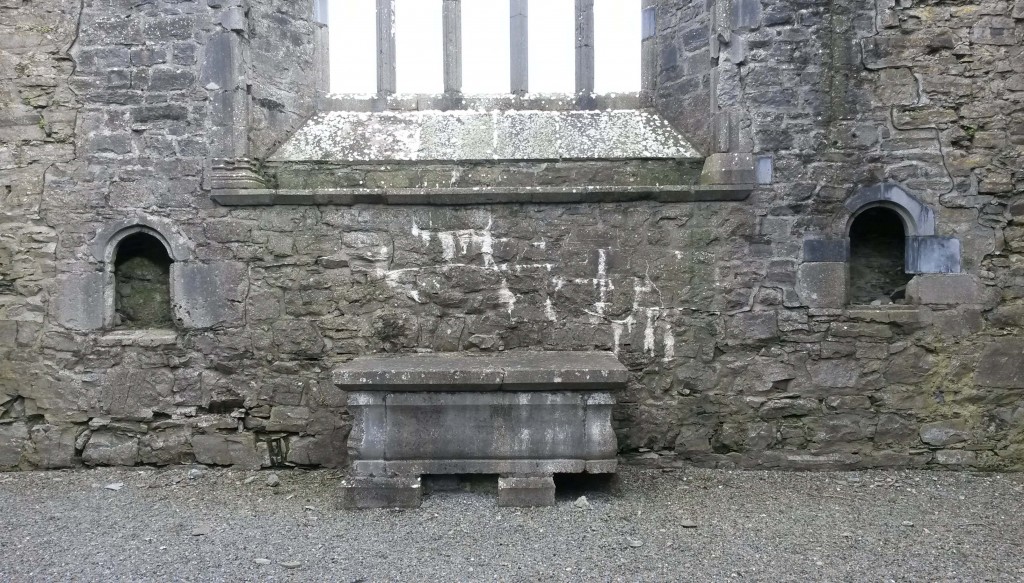© Donal G. Burke 2015
The Kelly family established as a landholding family in the townland of Kellysgrove, south of the town of Ballinasloe in east Galway from the mid seventeenth to the mid nineteenth century were of a different origin to the O Kellys of Uí Maine and are more correctly Kealys or Keallys.
The arms of this family were given in an armorial pedigree of one Colonel William Cruice of Summerhill in County Roscommon, who died in 1826 and whose mother was ‘Catherine, daughter of William Kealy of Tumgarty,’ by which name the modern townland of Kellysgrove was formerly known.[i] The arms of John Cruice of Summerhill, who died in 1816 at the age of 98 years, husband of Catherine Kealy, were shown impaled with the arms of Cruice on the dexter side and the paternal arms of Catherine Kealy on the sinister. The arms of this Kealy or Kelly family were given tricked as ‘per bend sinister Argent and Sable, two lions rampant counter-charged.’
The impaled arms of John Cruice of Summerhill, County Roscommon, who died in 1816, husband of Catherine Kealy or Kelly, after those sketched in the Cruice armorial pedigree in NLI., Dublin, G.O. Ms. 205 Will Pedigrees, Volume 3.
While Catherine is described as ‘Kealy or Kelly’ in the armorial pedigree, the arms of this family are clearly not those of the O Kellys of Uí Maine and, when taken in conjunction with details from family pedigrees and elsewhere, confirm this family, who later came to use the name Kelly, as originally Kealy or Keally and of separate and distinct origin to those Kellys from whom derived the chieftains of Uí Maine in east Galway.
The arms of a senior family of the name Kealy or Keally, (later known as Kelly) transplanted from County Kilkenny to County Galway in the mid seventeenth century, after the Cruice armorial pedigree in NLI, Dublin, G.O. Ms. 205 Will Pedigrees, Volume 3. No crest or motto was given in this source.
One of the earliest of this family associated with the eastern region of County Galway was one William Kealy, described in a pedigree of the family maintained in the office of the Ulster King of Arms as ‘Captain in the Army, transplanted by Cromwell from Waterford or Kilkenny to Tomcarty in County Galway in 1676.’ (The date given, however, was incorrect and should have read 1656.)[ii] The same pedigree gives him as son of James O Kealy, the eldest of four offspring of William O Kealy. The younger siblings of this James were given as John, William and Mary.
Edward MacLysaght in his ‘Irish Families’ makes the distinction between the Kellys of Uí Maine, whose name in Irish was originally Ó Ceallaigh and the Kellys of Kilkenny and Tipperary. The latter family of Kilkenny and Tipperary he states are not Ó Ceallaigh but rather Ó Caollaidhe, ‘some of whom retain the older form Kealy, which is Quelly in County Waterford.’[iii] In his ‘More Irish Families,’ MacLysaght makes the further distinction between the Kealys of Kilkenny and the ‘Keeleys of County Galway,’ the latter he surmised being of ‘the sept Ó Cadhla’ and noted that Ó Cadhla, ‘called O Kealy by Hardiman in his notes on O Flaherty’s ‘Iar-Connaught,’ was chief of Connemara up to the time of the Anglo-Norman invasion of Connacht.’[iv]
Tuomcatry alias Kellysgrove
The ‘Tomgarty’ whereto William Kealy was transplanted was also known as ‘Tuomcatry’ or variants thereof and in the late medieval period lay immediately outside of the O Madden territory of Síl Anmchadha. As such, it lay in the late medieval period within the immediate territory of a sub-branch or sept of the O Kellys whose wider lands comprised for the most part the later half barony of Clonmacnowen.
Situated immediately north of the later abbey of Clontuskert and south of the much later town of Ballinasloe, Tuomcatry was originally known as Tuam Chathraighe, and derived its name from the presence in ancient times of an early tribe of people who inhabited this area about the later parishes of Kilclooney and Creagh, straddling the River Suck, about the time of the rise of the Uí Maine, who subjugated them.[v] The tribe were known as the Catrigii or ‘the Cathraighe of the Suck’ and appear to have been allowed to remain within their original location for a time by the descendants of Maine mór. They were described in an account of the relationship of the tribes of that region to the O Kelly over-chieftain as one of ‘the enslaved tribes of Hy-Many for servitude,’ their territory extending from ‘Upper Tuaim Cathraighe to Porta Fidigi on both sides of the Suck.’[vi] The historian Fr. P.K. Egan identified ‘Upper Tuaim Cathraighe’ as a ‘portion of an area in Kilclooney parish extending over the townlands of Poolboy and Kellysgrove, astride the present boundary of Clontuskert and represented by the seventeenth century denominations, now obsolete, of Tomoughter, Tomeeter and Tomcatry.’[vii]
The townland itself comprises of a rise of ground composed for the most part of gravel, atop which stood at one time a sharply raised mound. Nearby, along the same height, was located a children’s burial ground, identified as a ‘cillin.’ A large area of the surrounding land in the townland fell away to the east and northeast across boggy land towards the River Suck, rendering much of the denomination unprofitable. A large area of meadow near the river in the mid seventeenth century was recorded in the mid seventeenth century as being flooded throughout the winter.[viii]
For further information in relation to Tuomcatry refer to ‘O Coffey’ under ‘Families.’
Tuomcatry formed the greater part of the ancestral lands of the O Coffeys, who maintained a minor presence in the area about the parish of Clontuskert. The O Coffeys lost possession of their lands in this area as a result of the Cromwellian confiscations and transplantations in the mid seventeenth century. All of the lands of Tuomcatry would appear to have been allocated by the Cromwellians to the Kealy family.
At least two Kealys, but identified as ‘Kelly’ were ordered to transplant to the half barony of Clonmacnowen in east Galway. In 1656 William Kelly of Goran in County Kilkenny was allocated 347 acres and Thomas Kelly of Farnoge in County Kilkenny was allocated 585 acres.[ix] William’s lands appear to have been located in the parish of Kilclooney (in addition to those in Clontuskert) while those of Thomas were located in the parishes of Kilclooney and Kilgerrill.[x]
The Restoration of the Monarchy and Acts of Settlement
Following the turmoil of that period and the restoration of the monarchy in the person of King Charles II in 1660, an Act of Settlement was passed in Parliament, in an attempt to address the complaints of those whose lands had been taken or divided by the Cromwellians and to placate those who had acquired lands at that time. Under the Act of Settlement all of the townland of Tuomcatry was confirmed in the possession of James Keally.[xi]
Under the Act of Settlement James Keally was confirmed in the ownership of 306 profitable Irish acres, formerly the property of the O Coffeys and a small parcel of which had formed part of the estate of one John Kelly. He was also confirmed in possession of 47 profitable Irish acres in the nearby townland of Mackney and may have been the same man as ‘James Kelly’ confirmed 25 acres in Gortcarne in the parish of Clontuskert.[xii]
Under the same Act Thomas Keally was confirmed in possession of 158 profitable Irish acres in the townland of Mackney and 199 acres in the townland of Lisnacasley in the parish of Kilgerrill, much of which had formerly been part of the lands of various O Kellys. At the same time one Bryan Kealy was confirmed as owner of 35 profitable Irish acres in the townland of Mackney.[xiii]
The pedigree of the Kealy or Kelly family of Kellysgrove gives ‘James Keally or Kelly of Tomcarty’ as the eldest son of that Captain William Kealy who had been transplanted and brother of John Kealy. James Keally was married to Eleanor, daughter of John Nally of Dunmore in County Galway by Sarah, daughter of Edmund mor Donelan of Killagh.[xiv] An armorial pedigree relating to a Cruice family descendant of James Kealy gives him as ‘James Kealy of Tumgarty in County Galway, Esquire,’ and gave his arms tricked as ‘per bend sinister Argent and Sable, two lions rampant counter-charged.’[xv]
James Kealy or Kelly of Tumcatry and his wife Eleanor had at least two sons, William, his eldest son and heir and another, who became a Franciscan friar. The Kelly of Kellysgrove family pedigree gives Catherine, wife of John Cruice of Summerhill in County Roscommon as daughter of this James.[xvi] However, this is contradicted by the Cruice armorial pedigree which originally gave Catherine as daughter of James but was subsequently corrected to show her as a daughter of James’ son William. This later correction in the Cruice armorial would appear to be correct in corresponding to the dates of death of Catherine, her son and her son’s father-in-law.
William Kealy or Kelly, son of James, appears to have flourished about the early eighteenth century and was the first of the family to be described as ‘of Kellys grove’ and ‘seized of the lands of Mackney, Tomgarty, Eskerkeel, etc. in County Galway.’[xvii] He married Elizabeth, daughter of George Shee, Esquire and had at least one son, named William and possibly three daughters; Elizabeth, Mary and, on the basis that the corrections to the Cruice armorial are correct, Catherine, wife of John Cruice. The family from about this time would appear to use the name Kelly almost exclusively, as ‘Kealy’ no longer appeared in the family pedigree and their residence was given thereafter in the pedigree as Kellysgrove.
Tumcatry or Tuomcatry from about this time came to be known in its entirety as Kellysgrove, as was the principal residence of the family, built at a distance from the road, and to the south west of the ancient mound, the highest point in the townland. The house, that became known as Kellysgrove House, appeared later in the mid nineteenth century as a large three storied house with little architectural elaboration.
Of the children of William Kelly and Elizabeth Shee of Kellysgrove, their only son William inherited the family estate and married Mary, daughter of Martin Browne of Clonfad in County Roscommon, while their daughter Elizabeth married one John Netterville and Mary married John Burke of Keeloge, a junior branch of the Burkes of Glinsk in north-east Galway.[xviii]
William Kelly of Kellysgrove and his wife Mary Browne had at least two sons; Denis and William. Both were described as ‘of Kellysgrove’ but Denis was the elder. Denis Kelly married Elizabeth, commonly known as ‘Bessie’, daughter of Lewis O Donel of Oldcastle in County Mayo.[xix] His will was dated 13th April 1813 while that of his younger brother William of Kellysgrove was dated 13th January 1809.
Denis Kelly of Kellysgrove and his wife Elizabeth O Donel has at least three sons and two daughters; William James, born in December of 1806, James, Charles, Louisa, who died young and Elizabeth, who later married Captain Edward John Cruice.[xx]
Denis Kelly’s brother-in-law Manus, son of Lewis O Donel and grandson of Charles O Donel of Newport in County Mayo, served as a captain in the British army during the Napoleonic Wars. According to the antiquary John O Donovan he ‘distinguished himself by his bravery in Colonel Spenser’s regiment in Holland where he was severely wounded in the hip, as he defended a passage from the ford of a river over which the late Frederick Duke of York had passed in his flight from the pursuing French.’[xxi] He returned to Ireland and was cared for by his sister Elizabeth of Kellysgrove until he died as a result of his wounds on 13th February 1812 at the age of thirty-seven years. He was buried in the ruins of the priory church at Clontuskert under an altar tomb erected in the location of the former high altar below the east window.[xxii]
The burial place of Captain Manus O Donel, brother-in-law of Denis Kelly of Kellysgrove, under the east window of the ruined church of Clontuskert priory. Lord Walter Fitzgerald recorded the inscription on the tomb in 1912 as ‘O Lord have Mercy on the / Soul of Captn Manus O’ / Donel, late of the 40th Regemt / of Foot, who dept this life / 13th Feb 1812 Aged 37 years. / Erected by his brother / Lewis O’Donel. Fitzgerald, however, described it as a box-tomb located ‘on the north side of the cloisters.’
Denis Kelly appeared as the only tithe-payer at Kellysgrove in the Tithe Applotment Books of 1823.[xxiii] In 1837 William James Kelly was resident there.[xxiv]
The departure of the Kellys from Kellysgrove
The Kellys, like a number of the long-established landowners in the county, were experiencing significant financial difficulty by the mid nineteenth century and in 1850 Kellysgrove house and estate was offered for sale by William James Kelly (commonly known as James Kelly) as an Encumbered Estate. A large part of the estate was subsequently purchased by the Earl of Clancarty, who was seated at Garbally, Ballinasloe, while a portion was also acquired by a Scotsman named George Ramsay Campbell, ‘to whom the estate was largely indebted.’[xxv] Clancarty proceeded thereafter to facilitate the shipping of many of the Kellysgrove tenantry to the United States of America.[xxvi]
William James Kelly did not long survive the sale of the family estate, dying in 1855 when, while attending a race-meeting at Knockbarron, Loughrea in May of that year, he fell from a height when the overcrowded stand-house collapsed. While it was initially thought that his spine had been dislocated when hit by a plank in the fall, it was later believed that he, having been standing at the rear where the overcrowding was at its worst and where the break occurred, died as a result of others falling upon him.[xxvii]
[i] NLI, Dublin, G.O. Ms. 205, Will Pedigrees, Vol. 3.
[ii] NLI, Dublin, G.O., Ms. 205, Will Pedigrees, Vol. 3, pp. 278-9.
[iii] MacLysaght, E., Irish Families, Their Names, Arms and Origins, 4th Edition, Irish Academic Press, Dublin, 1985, p. 112.
[iv] MacLysaght, E., More Irish Families, O Gorman Ltd., Galway & Dublin, 1960, pp. 272-3.
[v] Egan, P.K., The Parish of Ballinasloe, its history from the earliest times to the present century, Clonmore & Reynolds, Dublin, 1960, pp. 18-20.
[vi] O Donovan, J., Tribes and Customs of Hy Many, commonly called O Kelly’s Country, Irish Archaeological Society, Dublin, 1843, pp. 83-4.
[vii] Egan, P.K., The Parish of Ballinasloe, its history from the earliest times to the present century, Clonmore & Reynolds, Dublin, 1960, pp. 18-20.
[viii] MacGiolla Choille, B. (ed.), Books of Survey and Distribution, Vol. III, County of Galway, Dublin, Stationary Office for the I.M.C., 1962, p. 128.
[ix] Historical Manuscripts Commission, Fourteenth Report, Appendix, Part VII, The Manuscripts of the Marquis of Ormonde, Vols. I, II, III, London, Eyre & Spottiswoode, 1895, p. 144.
[x] Simington, R.C., The Transplantation to Connacht 1654-58, Shannon, Irish University Press, for the I.M.C., 1970, p. 93.
[xi] MacGiolla Choille, B. (ed.), Books of Survey and Distribution, Vol. III, County of Galway, Dublin, Stationary Office for the I.M.C., 1962, p. 128.
[xii] MacGiolla Choille, B. (ed.), Books of Survey and Distribution, Vol. III, County of Galway, Dublin, Stationary Office for the I.M.C., 1962, p. 128.
[xiii] MacGiolla Choille, B. (ed.), Books of Survey and Distribution, Vol. III, County of Galway, Dublin, Stationary Office for the I.M.C., 1962, pp. 128, 132.
[xiv] NLI, Dublin, G.O., Ms. 205, Will Pedigrees, Vol. 3, pp. 278-9.
[xv] NLI, Dublin, G.O. Ms. 205, Will Pedigrees, Vol. 3.
[xvi] NLI, Dublin, G.O., Ms. 205, Will Pedigrees, Vol. 3, pp. 278-9.
[xvii] NLI, Dublin, G.O., Ms. 205, Will Pedigrees, Vol. 3, pp. 278-9.
[xviii] NLI, Dublin, G.O., Ms. 205, Will Pedigrees, Vol. 3, pp. 278-9.
[xix] O Donovan, J. (ed.), The Annals of the Kingdom of Ireland, Vol. VI, 2nd edition, Dublin, Hodges, Smith & Co., 1856, p. 2396; NLI, Dublin, G.O. Ms. 205, Will Pedigrees, Vol. 3.
[xx] NLI, Dublin, G.O., Ms. 205, Will Pedigrees, Vol. 3, pp. 278-9.
[xxi] O Donovan, J. (ed.), The Annals of the Kingdom of Ireland, Vol. VI, 2nd edition, Dublin, Hodges, Smith & Co., 1856, p. 2396.
[xxii] Fitzgerald, Lord W. (ed.), Association for the Preservation of the Memorials of the Dead, Ireland. Journal for the year 1912, Vol. VIII, No. 6, p. 567; Molloy, J. (ed.), The Parish of Clontuskert, Glimpses into its Past, Clontuskert Heritage Group, Ballinasloe, 2009, p. 61.
[xxiii] Molloy, J. (ed.), The Parish of Clontuskert, Glimpses into its Past, Clontuskert Heritage Group, Ballinasloe, 2009, pp. 460, 464.
[xxiv] Molloy, J. (ed.), The Parish of Clontuskert, Glimpses into its Past, Clontuskert Heritage Group, Ballinasloe, 2009, pp. 460, 464.
[xxv] Melvin, P., Estates and Landed Society in Galway, Edmund Burke Publisher, Dublin, 2012, p. 83.
[xxvi] Melvin, P., Estates and Landed Society in Galway, Edmund Burke Publisher, Dublin, 2012, p. 83.
[xxvii] Dublin Evening Post, 15 May 1855; Galway Mercury and Connaught Weekly Advertiser, 26 May 1855, p. 1; Molloy, J. (ed.), The Parish of Clontuskert, Glimpses into its Past, Clontuskert Heritage Group, Ballinasloe, 2009, p. 464.




